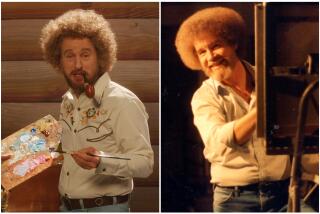Unique Craft is Part of the Local Color
- Share via
BOSTON — A rainbow flows from Bob Rossi’s basement workshop--an eccentric palette of eggplants, melons and jellybeans.
Rossi is one of the last “mix masters,” artisans who mix tints and paints to match or produce colors to order. These days, the work is done mostly by computers, or it is not done at all--colors are standardized.
But Rossi continues to color his world, vigorously stirring a long wooden board in a trash can as he blends a little of this and a little of that to match the hue of, say, a certain melon. It is all done by hand, and eye.
“I’m sure there are other people around that can do it, but not like I do,” he said, his shirt and once-white pants spattered with paint. “I’m about the last of the breed of color mixers, color matchers--who do it by hand.”
Rossi’s had some odd requests in his 32 years with Johnson Paint Co.
“They come in with eggplants, the inside of cantaloupes,” he said. “I had an MIT fraternity house come in and they wanted the inside of a watermelon. Real crazy things.” The late conductor Arthur Fielder asked him to duplicate a purple jelly bean.
Rossi recently created colors for Boston Edison, to be used at the Pilgrim Nuclear Power Plant.
Even for something as seemingly straightforward as gray, Rossi started with several gallons of snow-white paint, then deftly added black, a touch of dark brown and a mustard yellow. Then an added touch of black, a drop of yellow.
“It’s just like baking a cake,” he said.
At last, he had the precise gray Boston Edison requested. “It’s something you have to learn, but it’s a gift too, I guess,” he said.
The Johnson Paint store sits on a section of Newbury Street where wealthy Brahmins built their horse stables in the 1800s. The sidewalks outside still tilt toward the street as they did in the pre-automobile days, to aid in washing out the horse stalls. But the stables now are trendy clothing stores, hair salons and Johnson Paint, which arrived during World War II.
In Rossi’s workshop, turn-of-the-century trappings remain, including ropes and pulleys on the wall. But the floor is thick with dried paint droppings and the walls are painted in colors that “weren’t quite right.”
Rossi, 53, was a student on summer break when he saw a newspaper ad for a mixer at Johnson Paint.
“They asked me what I knew about colors, and I just knew the basic primary colors--you know, yellow and blue make green. But I got the job.”
He started as an apprentice to John Johnson Sr., the store’s founder, and has been there ever since. His methods have remained rooted in the 19th Century, even as the paint industry has raced toward the 21st.
Bernice Bolek, a spokeswoman for Glidden Co., the paint company based in Cleveland, said Rossi is “certainly unique.”
“It’s all computerized,” Bolek said. “A person will come into a paint store and hold up a sample of their color to a computer, and an (electric) eye scans the sample and finds the match” in the standard paint colors. Custom colors are created with the aid of tinting machines, she said.
Rossi said Johnson Paint once brought in a computerized color mixer to help, but it didn’t last long. “We had a computer here for two or three days. But Mr. Johnson just took it out, because he said: ‘I’ll take my man over the computer any day,’ ” he said.






